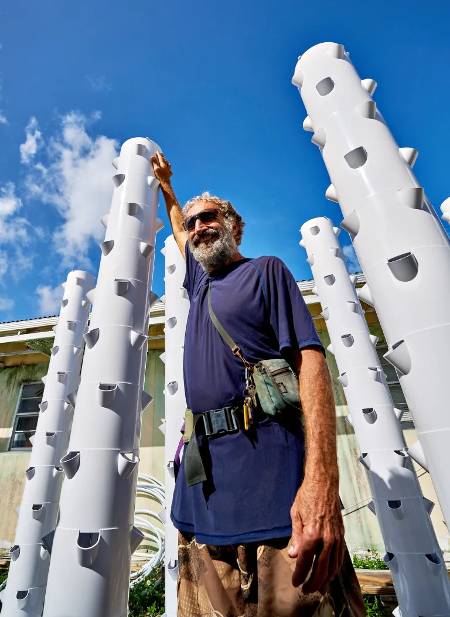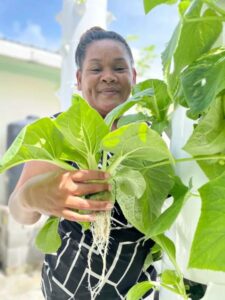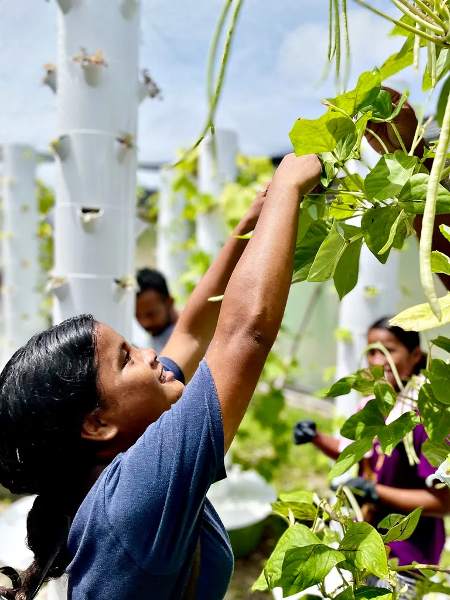Marshall Islands: Growing Vegetables in the Air
When trying to find a solution to the diabetes problem that afflicts residents of the Marshall Islands, yachtie Don Arkin and Tanner Smith from the Wellness Centre in Majuro found an innovative way to grow fresh vegetables in a place without good soil. Fellow sailor Ken Cone reports on their project.
Published 2 years ago, updated 7 months ago
How do you grow vegetables in a place without good soil? Or without space for big gardens? And what if water is sometimes scarce — for example in many of the outer atolls?
Yachties are getting involved in the Marshall Islands and Don Arkin, a yachtie who is now the head gardener at the Wellness Center, says the answer just may be “aeroponics.” In an aeroponics installation, vegetables grow in clusters along the sides of eight-foot towers, with their roots dangling inside the towers.


An aeroponics array is like a high-rise apartment complex for lettuce, tomatoes, bok choy, eggplants, beans, and other vegetables. For three minutes out of every 15, water and nutrients are pumped into the pipes at the top of each tower.
This allows the water to trickle down over the roots, moistening them and providing minerals and fertilizers which the vegetables need. The unused water flows back into a tank at the base of the tower, awaiting the next pump cycle.
“We’ve tried hydroponics, where the roots are immersed in water, but vegetables grow better when their roots are not constantly wet. So when I heard about aeroponics, I thought we should try that here in Majuro,” says Tanner Smith, who is the Director of the Wellness Center. “We now have 30 towers (which were manufactured by the Tower Gardens company in the US), each with 44 slots for a vegetable plant.” This equates to 1,320 individual vegetable plants.
Vegetables can solve diabetes issues


“We have a terrible problem with diabetes here in the Marshall Islands,” explains Tanner.“Eating vegetables would help with that, but are very expensive because most need to be flown in. Also, because vegetables have never been easily available, people are not accustomed to eating them. We hope that a cheap source of fresh vegetables will encourage people to vary their diets which could really improve the health situation here.”
The Wellness Center, which was created by the Canvasback Foundation and is located at Majuro hospital, has been working with the Ministry of Education, the Non-Communicable Disease Coalition (which is made up of NGOs and government organizations) and the Ministry of Health and Human Services. The hope is that there will a steady supply of fresh vegetables to the schools for school lunches. To complement this, there will be programs that will educate students and teachers about the importance of a healthy diet.
Ninety-eight percent less water
Head Gardener Don explains that aeroponics technology can also be used to improve diet in the outer atolls. “Very little of the water is lost through evaporation, since it all stays inside the tower, so the system is very water efficient,” he explained. “That should make this approach to farming particularly attractive for atolls that don’t get a lot of rain.” In fact, the manufacturer claims that an aeroponic system uses 98 percent less water than conventional farming.
Aeroponic farms are also less vulnerable to diseases and insects since the plants do not come into contact with any soil. And if a disease is established, it is easier to clean out the tower and re-plant compared to a conventional farm, where the disease and insect eggs remain in the soil. Other benefits include no digging and no weeding. Plus a tower only needs six square feet of space and some sunlight. What’s not to like?
Fully automated watering
The towers at the Wellness Center are fully automated: The float switches draw new water into the tanks when needed. The new water passes through a mixing tank where the necessary minerals are added automatically. Simpler systems are available for households and for areas that don’t have pressurized water supplies. The Tower Gardens company sells a somewhat smaller residential unit for $300, which includes an automatic pump but requires the owner to replenish the water and minerals by hand.
Don also explained that the Wellness Center’s aeroponic installation will run primarily on solar power, using efficient water pumps and drawing on a new 2,400 watt solar array. The array will charge a large battery bank, allowing the system to run overnight.


Volunteer Yachties
Yachties Dave Himle, of sailboat Lucile, and myself, of Eagle’s Wings, volunteered their time to wire up the array. The RMI NCD Coalition obtained funding for the aeroponics project through the United Nations Development Program through its GEF small grants program. The Matson shipping company provided free shipping from the US to Majuro.
Ken Cone
SV Eagle’s Wings
FOOTNOTE: The first crop of vegetables including lettuce, bok choy, tomatoes, eggplant, beans and other veggies were harvested in March 2022.
…………………………………………………………………………………………………………………………………………
Reproduced with kind permission from the author. This article first appeared in The Marshall Islands Journal in February 2022
………………………………………………………………………………………………………………………………………….
The opinions expressed in this article are the author’s own and do not reflect the view of Noonsite.com or World Cruising Club.
Related to following destinations: Majuro, Marshall Islands
Related to the following Cruising Resources: Cruising Impact, Cruising Information, Environment, Volunteer Projects for Cruisers





